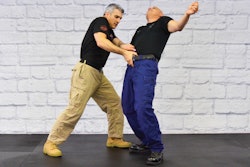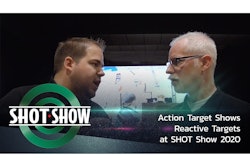 Features like 4K, augmented reality, virtual reality, and WiFi connected screens are paving the way for the next generation of scenario-based instruction.Photo: Getty Images
Features like 4K, augmented reality, virtual reality, and WiFi connected screens are paving the way for the next generation of scenario-based instruction.Photo: Getty Images
Computer-based simulator instruction has been a part of law enforcement training for several decades now. And over time these systems have become more and more sophisticated. Yet they have, for a variety of reasons, never been able to accommodate some of the more complex training scenarios—multiple officers, tactical movement, subtle threat cue recognition, and crisis intervention with diminished individuals—that police instructors would like to use in their programs. New technologies and content are now being added to these systems that will make this kind of training much more effective in the simulator environment.
At last year's International Association of Chiefs of Police (IACP) Show, all of the major law enforcement training simulator companies showcased some of their newest technologies and features for their systems, including:
Higher Resolution
The scenarios used in law enforcement training simulators have long been filmed in higher resolution than they are projected onto the screens. The reason for this is that the companies that shoot the interactive videos have great cameras and until recently projectors that could duplicate those high resolution digital captures were cost prohibitive. Now the projectors have come down a lot in price, so several simulator makers are selling 4K systems.
Still, your training budget is probably limited or worse strained so the thing that you need to know most is what's the difference. A simulator is not a TV set. 4K in this equipment is not about pretty pictures; it's about training benefit.
Lon Bartel, senior subject matter expert for VirTra, says the crystal clear 4K resolution now available on some VirTra simulators will aid law enforcement training by revealing details that can indicate a subject is about to attack or flee. "You see the detail of the person's face, so you can read the threat cues," he says. "You can even see pupil changes and quick glances that you will not see in standard HD."
And if you want to see how sharp the VirTra 4K is, Bartel recommends you test out the simulated range, especially the simulated long range. "With standard HD if you push a human-size target out to a simulated 800 meters, it will look like three or four pixels. With 4K, I can push that target out to a simulated 800 meters, and it will have so much detail that you can use magnified optics on it," he explains. Bartel says he has used as much as 4X magnification for simulated long-distance shots on VirTra's 4K firearms training scenarios.
Augmented Reality
The headset is soon going to be a common sight during police simulator training, as more and more companies are exploring computer-generated imaging as a training medium. Several simulator companies are working on or are now offering augmented reality (AR) or mixed reality (MR) options for their systems. With AR/MR the trainee wears a headset that partially covers their face and shows them things that really don't exist, but the trainee can also see the real world at the same time. This is different from virtual reality, where the headset covers the trainee's face and they can only see what the computer is rendering in the headset.
Companies that sell AR/MR systems for law enforcement training say the major advantage over VR is that the officer can see their tools, including the sights on their firearms. "VR is completely immersive, and it entirely shuts out the physical world," says Robert McCue, general manager of MILO Range Training Systems. "We've been focusing here at MILO on MR because that offers the trainee complete freedom of movement. Officers are free to interact with the real world (including their tools)."
AR and MR features are being rolled out by a number of companies in the law enforcement simulator market. Ti Training showed its AR option at last October's IACP. Ti Training's AR option allows the instructor to introduce objects like brick walls and patrol cars into scenarios that are being run inside buildings. The next step is volumetric video, which allows the instructor to introduce 3D images of people standing in the room that the officer has to interact with while also working the scenario projected on the screen.
Todd Brown, vice president of Ti Training, gives this example that is all too familiar to police officers working in contemporary America. "There's a volumetric video of a person standing in the room videoing you on their cell phone and they're telling you how they're going to ruin your career."
The Virtual World
While some trainers and simulator makers doubt the value of current full-headset virtual reality technology in police training, it is coming. Axon has produced a number of non-scenario-based training sessions in VR.
And Meggitt Training Systems (FATS) is getting ready to launch a scenario-based VR system for law enforcement. Meggitt says it can overcome the concerns some trainers have expressed about officers not being able to see the real world while running VR scenarios.
Meggitt's Jonathan Ayala says the key to making scenario-based VR training valuable for law enforcement is going to be the "fidelity" of the computer-generated graphics. He explains that officers will not be holding home video game VR remote controls when using the Meggitt VR system; instead they will be holding accurate replicas of their tools. "Our synthetic weapons that trainees use in our VR system replicate the real weapon to the fullest extent possible," he says.
Still, even if the replica weapon in the student's hands is absolutely perfect in detail and non-firing functions, the student will only be seeing a computer version of that weapon in the VR environment. Ayala believes Meggitt has technology to overcome any concerns about officers not being able to see their real-world sights. "The sight picture is accurate as long as you pair up the sensors that we have in the (replica) gun with the simulation software. If I have sight alignment in the VR world, it will be true to the real world because of the sensors we have in the synthetic (non-firing) weapon," he explains.
Despite any limitations VR might have in terms of officer training, it also has immense potential, particularly for running multiple officer scenarios. "You will be able to see yourself and you can see your partners, and you will see them in the same position and distance away from you that you would see them in the real world," Ayala says. "And it's not going to be just a six-foot person every time. When you put on the system, the instructor will input your general size into the scenario so it will match your representation."
Meggitt also believes VR will help end the greatest limitation of projection-based scenario training systems: with projection systems the picture doesn't change when the student moves. Ayala says this aspect of VR will be invaluable for law enforcement tactical training. "If you move in VR the angle of what you are seeing will change. That will help teach officers the value of cover and concealment, and help them understand that if they deploy a weapon they need to know what is behind the target. It will help make them much more tactically aware."
Another training benefit of VR, according to Ayala, will be the instructor's view. The instructor will be able to see everything the student sees in the VR environment and a God's eye view of the scenario from a display. The instructor will also be able to record all the action for the debrief.
Eye Tracking
Technology that shows where the student is looking and relays that information to the instructor is another new feature that some simulator makers are building into their systems.
At last October's IACP show L3Harris demonstrated its new PatrolSim driving trainer. The latest innovation in the L3Harris PatrolSim is EyeTracker, a machine learning feature that monitors where the driver is looking and how their head is positioned during the scenario. This can be used to correct problems and warn students that they are taking their eyes off the road when using equipment.
"Officers can get complacent over time when driving vehicles. This complacency leads to bad habits that need to be addressed for the safety of the officer and the public," L3Harris says.
Of course one of the most dangerous bad habits in law enforcement driving is taking eyes off the road while multi-tasking or while monitoring information coming across the in-car laptop or the officer's smartphone. PatrolSim duplicates the environment of the contemporary patrol vehicle and the scenarios are designed to teach officers the hazards of distraction. In addition, scenarios "provide training on hazardous situations that are too risky to replicate or control at a training facility or on the road," the company says.
AR headsets can also help instructors learn if the officer was visually distracted while running a use-of-force scenario. Brown says Ti Training's new AR option can capture information about the head position of the student during the scenario. "For example, at a critical moment were your eyes on the subject's hands and the movement to the subject's waistband or were you looking at something else," Brown explains.
More Realism
Almost all technological advances in the law enforcement simulator market are designed to make the simulated training environment more realistic. This is generally accomplished through a mix of physical tools, high-quality visuals, and complex programming.
VirTra's new V-DTS police driving simulator is an example of how all the visuals, the physical features of the simulator, and the programming can create an effective training experience. The V-DTS features photorealistic graphics, a wraparound cockpit, programming that does a good job of mimicking physics, and an optional carriage that provides road feel.
"The carriage itself has a lot of travel, so we get more realistic movement of the vehicle," Bartel says. "You feel the vibration of the road, the change in pitch when you start to accelerate or brake. So you get a better physical and psychological fidelity of driving to support the training environment."
Multiple Screens
For years now simulator companies have been creating somewhat immersive training environments using multiple screens. The largest of these are usually 300-degree wraparound systems that leave one section open so that people can enter and exit. Multi-screen systems are also used to create large simulated shooting ranges. Then there's Ti Training's new Recon.
The Recon name is short for reconfigurable. That's just a small part of the capabilities of the system. Ti says that Recon can operate up to 24 screens.
Using multiple screens on Recon, a training scenario could move from room to room or even floor to floor. "Your entire building can become a simulator," Brown says. He offers the example of a scenario beginning with an officer interacting with a reporting party downstairs in a building to learn about the situation, then having to run up to the next floor to continue the scenario and contact the subject. At each station in the scenario a different instructor can monitor and direct the interaction.
The base Recon system is a three-screen, 180-degree training environment. But the Core computer of the system can connect with more screens via WiFi. Brown says none of the company's customers have maxed out the capabilities of the Core computer with all 24 screens, but at least one is running eight screens.
Recon can be used with laser training weapons or with marking rounds such as Simunitions. The Simunitions capable training environment is called Training Lab UltraWorld. It's a reconfigurable shoot house that incorporates four surfaces that can be used for video projection. The UltraWorld can also be used for force-on-force marking round training.
More Complex Scenarios
All of the new technology being built into the latest law enforcement training simulators is designed to make training more effective. In order to attain the greatest return on investment in these features, agencies need scenarios and other training materials that take advantage of the technologies.
Ti Training's multiple station scenarios are an example of how training materials can match the capabilities of the system. Meggitt's VR scenarios will be unlike any projected scenario because of the technology involved. VirTra's 4K scenarios include subtle threat cues and other information such as room numbers on doors during school shooter scenarios that were not as easily seen in standard HD.
The technology that MILO is now emphasizing is a different approach to the scenarios themselves. McCue says the focus is no longer on use of force but on the entire interaction with the subject.
"We are getting far away from shoot, don't shoot and focusing on the officer's ability to process the available information and make a number of different decision. The OODA Loop is observation, orientation, decision, and action. We are really overloading you on the front end of the OODA Loop with a lot of information," McCue says.
These new MILO scenarios start much earlier in the officer's contact. Instead of giving the officer all the information about the situation and putting the officer into an immediate confrontation with the suspect, they develop slowly and in a much more realistic manner.
"You have to be responsive and talk to citizens who are giving you information about the subject. You're going to have to go over and notice nonverbal clues from the subject and then engage with them verbally. And the outcome is entirely dictated by the trainee's response and the instructor's knowledge of how such a contact can be escalated or de-escalated," McCue explains.
The goal of MILO's new scenarios was to give agencies content they could use to train officers in the most likely encounters they will experience on patrol, including homeless people, people in mental distress, and people who are under extreme influence of drugs and alcohol. McCue says the company worked with leading experts to develop these scenarios for crisis intervention, which have been in development for three years.
The branching options for these crisis management scenarios are much more complicated than many of MILO's earlier scenarios, according to McCue. "We film 64 to 128 different responses from these individuals," he says. "Sometimes the officer may be asking them questions and they will just start rocking back and forth and the officer will have to deal with that."
MILO's crisis management scenarios can end in a variety of ways ranging from everyone safe, including the subject, or with a use of deadly force by the officer. The purpose of the scenario is to teach officers about dealing with people in crisis, but McCue stresses that the training is always about officer safety. "It's 100% grounded in officer safety," he says. "The trainees have a wide variety of force options they can deploy in response to threat presented by the subject. But the focus is not as it has been in the past, it not just about the deployment of firearms."
David Griffith is editor of POLICE/PoliceMag.com.
















